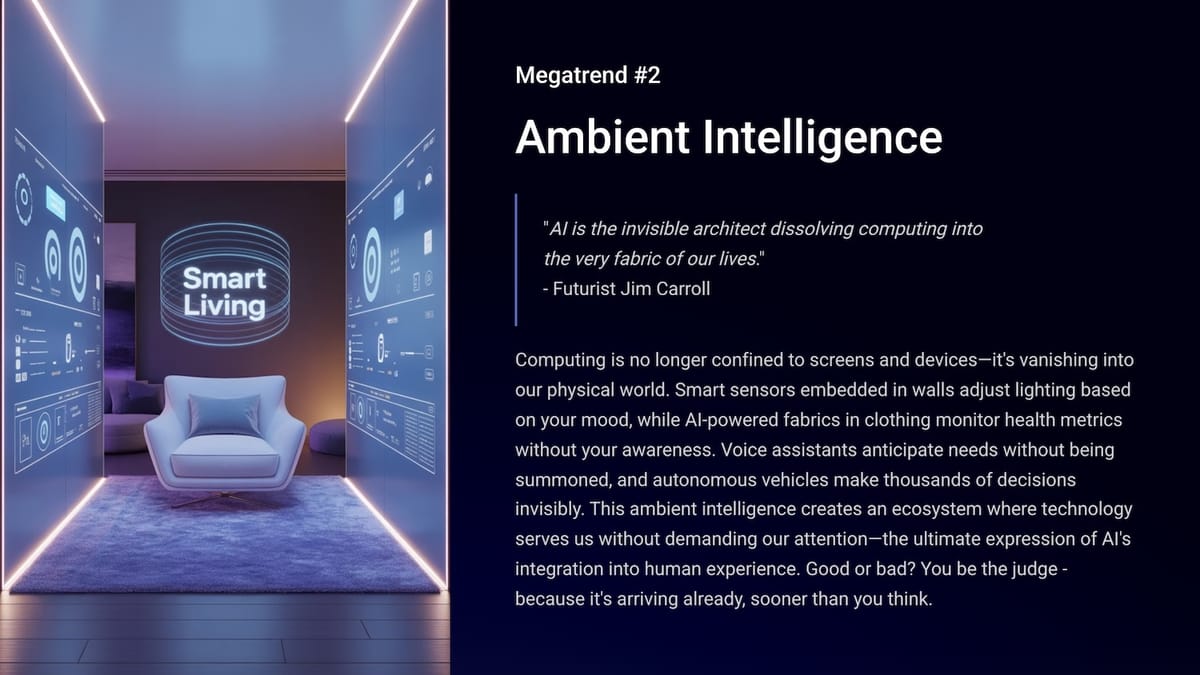"AI is the invisible architect dissolving computing into the very fabric of our lives." - Futurist Jim Carroll
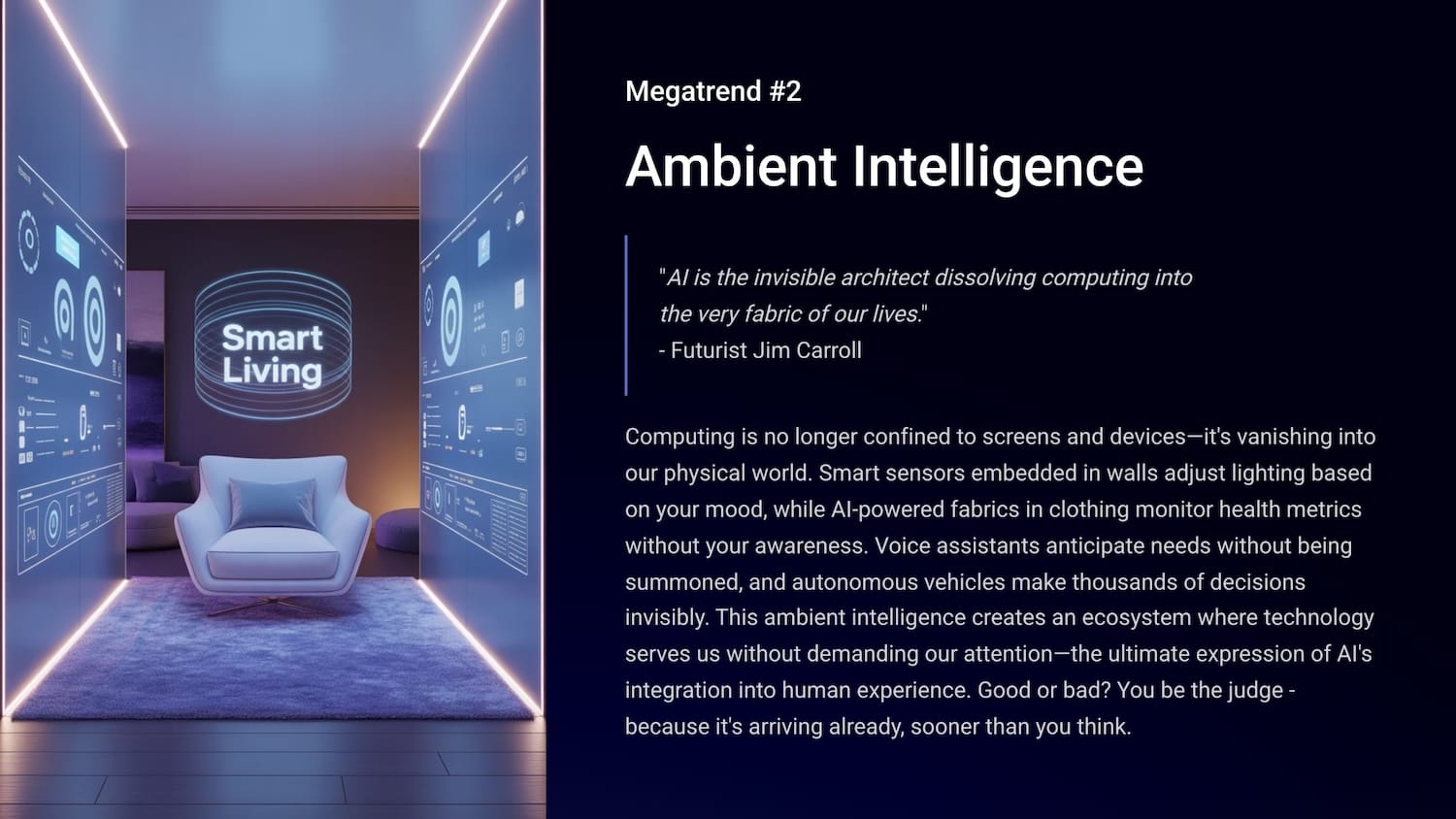
Computing is no longer confined to screens and devices-it's vanishing into our physical world. Smart sensors embedded in walls adjust lighting based on your mood, while Al-powered fabrics in clothing monitor health metrics without your awareness. Voice assistants anticipate needs without being summoned, and autonomous vehicles make thousands of decisions invisibly.
This ambient intelligence creates an ecosystem where technology serves us without demanding our attention-the ultimate expression of Al's integration into human experience.
Good or bad? You be the judge - because it's arriving already, sooner than you think.
This trend is kind of near and dear to my heart since I've been speaking and writing about it for almost three decades - albeit in the context of what I call "hyperconnectivity." And back in 2000, in one of the many Internet-related books I was writing at the time, I introduced the concept of the "IP-chip"—a visionary idea of a computer microchip with built-in Internet capabilities, designed to enable seamless global communication between everyday devices.
I took the liberty of feeding a chapter from one of my books from 1999 - Light Bubs to Yottabits - to an AI app to summarize what I covered, and what I missed. You can access the full PDF here. It's an interesting read!

This wasn't just about connecting gadgets; it was about embedding the Internet's universal language, Internet Protocol (IP), directly into the fabric of our world. My predictions (and I wasn't the only one making this one) proved remarkably prescient, laying the conceptual groundwork for what we now widely recognized as the Internet of Things (IoT).
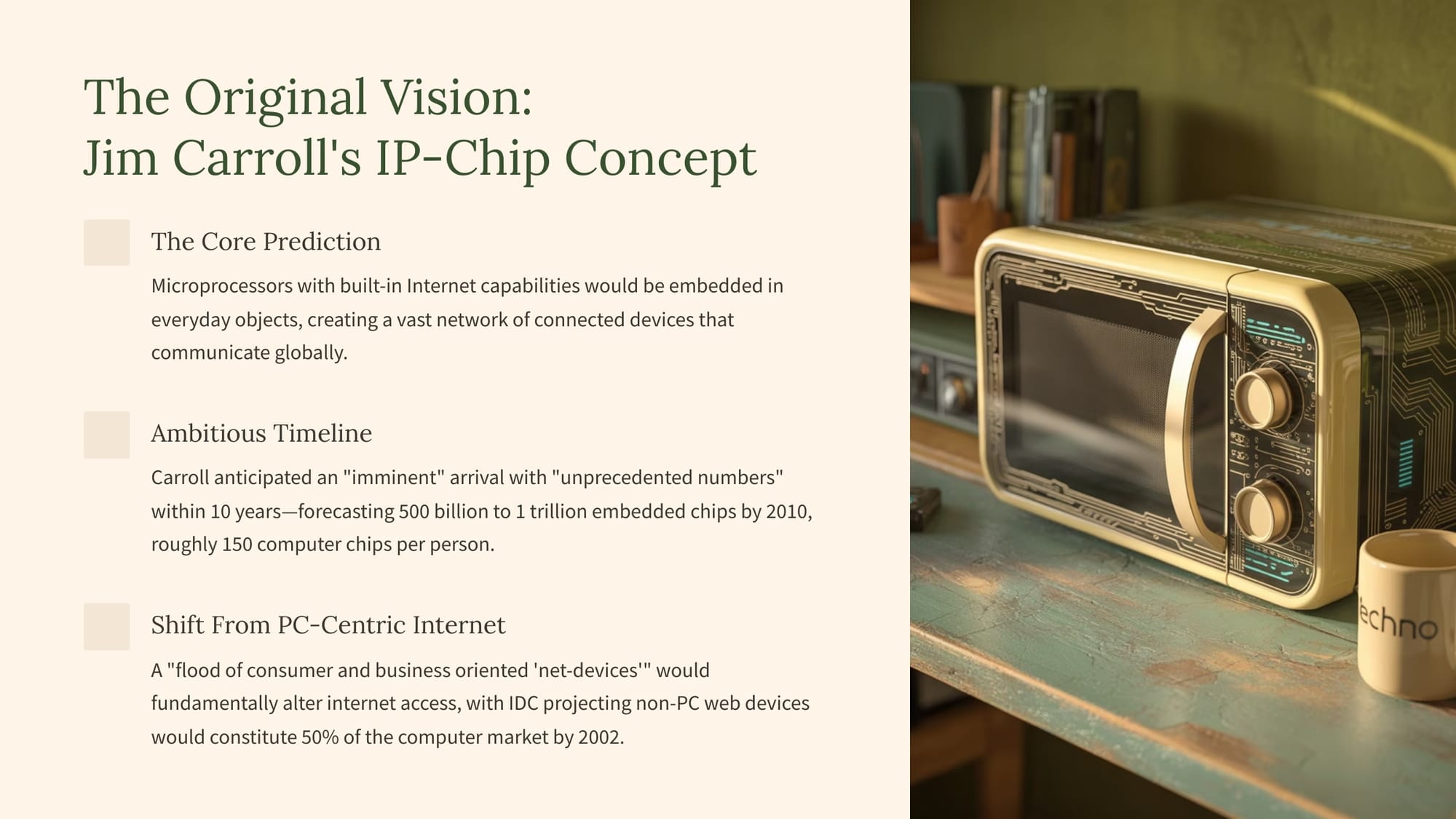
My prediction was that these IP chips would be "imminent" and would "invade your home or office in unprecedented numbers" within a decade, fundamentally shifting Internet access away from a primary reliance on personal computers. I envisioned a future where:
- Microwaves would perfectly pop popcorn by querying online databases.
- Refrigerators would email for repairs.
- Cars would wirelessly sync data with home networks.
- Even infrastructure, like bridges and highways, would become "Internet-aware," reporting real-time data.

Fast forward to 2025, and this vision of hyper-connectivity is undeniably our reality.
We're living in a world where computing is indeed disappearing into the environment around us, embedded in countless devices without screens or keyboards, creating seamless interactions. How big a trend is it? The global IoT market is now valued at over $1 trillion, with more than 18 billion connected devices actively in use, from smart home appliances to industrial sensors. The IP chip's promise of low cost and ubiquity has also largely materialized, making these "net devices" an expected, integrated feature of modern life.
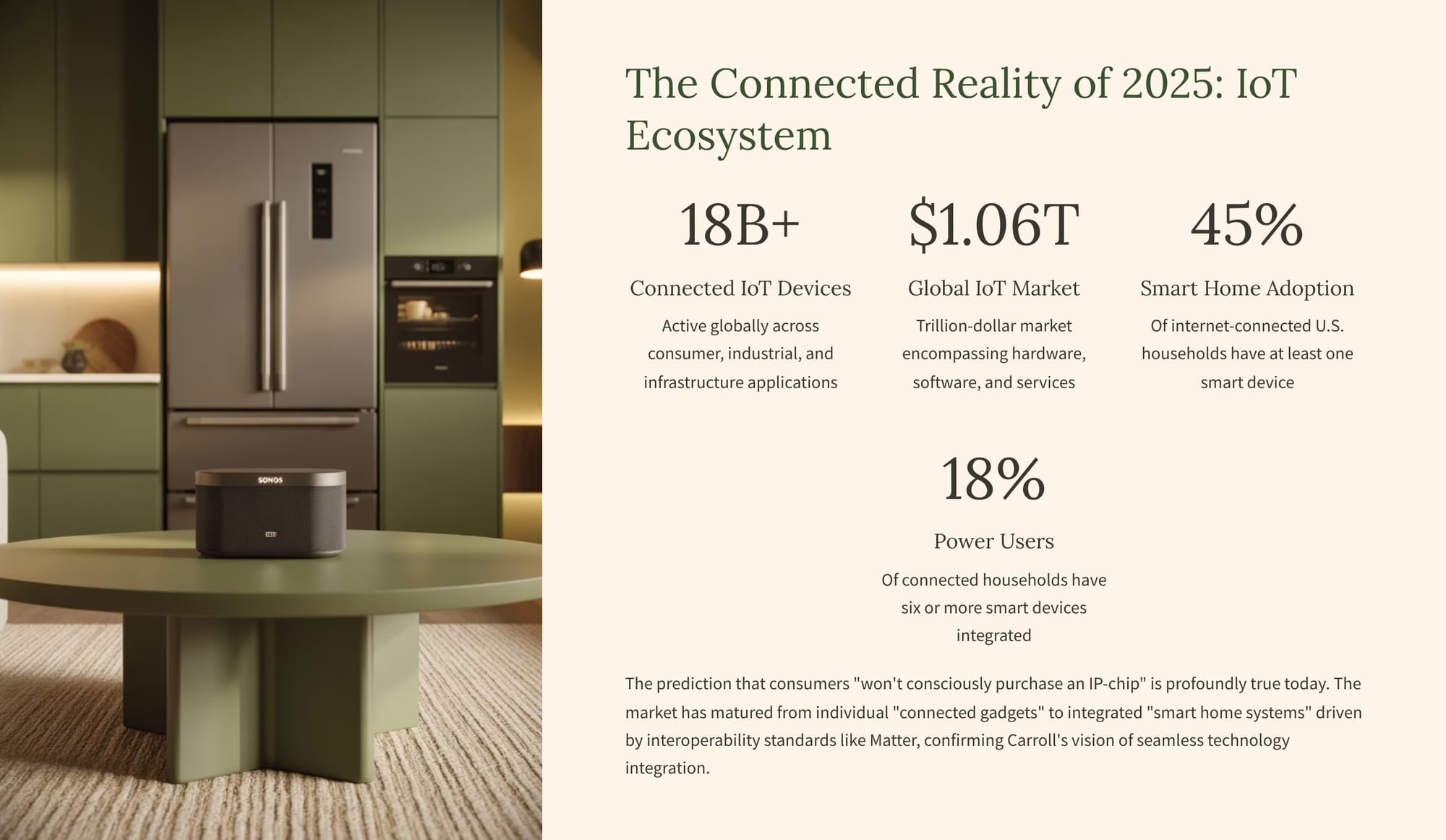
But that's only the first step. We're now about to integrate AI directly into all of these 'smart devices,' promising to make them 'smarter.' Good or bad? Will it make them better or worse? A great idea of a massive mistake? Debate rages.
Even so, it's going to happen, My original predictions suggested that these devices would possess a degree of "intelligence," but I didn't anticipate the massive acceleration of all trends related to AI. Thinking about it now, it seems that AI will provide the "brain" for this vast network of connected devices, transforming mere connectivity into true "smartness." This integration, now referred to as AIoT, enables devices to learn from data, make autonomous decisions, and automate tasks at a scale and speed far beyond what we can do. It allows for real-time data analysis, informed decision-making, and continuous performance improvement by learning from patterns.
Where will this lead? Here are a few examples of where we are already:
- Personalized Automation: AI-powered thermostats and smart plugs will learn user habits to optimize heating, cooling, and lighting, leading to significant energy savings.
- Seamless Interaction: Voice assistants, enhanced by Natural Language Processing (NLP), already allow us to control our smart home devices and manage daily routines hands-free, simply by talking to them. This allows for natural human-machine interactions, making devices easier to use for everyone.
- Advanced Security and Safety: AI-driven cameras and alarms provide real-time video monitoring, motion detection, and even facial and object recognition, sending instant alerts to our mobile devices and integrating with emergency services.
- Predictive Maintenance: AI analyzes vast amounts of IoT sensor data from urban infrastructure (like bridges, roads, water systems, and power grids) to detect potential failures before they occur, significantly reducing downtime and maintenance costs. Trucks report when they are going to break down before they break down. This is a key application in manufacturing and logistics as well, with digital twins offering enhanced predictive insights.
- Smart Traffic Management: Systems optimize traffic flow by analyzing vehicle and pedestrian data, enabling dynamic lane changes, real-time adjustments to traffic signals, and instant hazard alerts, thereby reducing congestion and emissions.
- Environmental Monitoring: AI processes data from IoT sensors to monitor air quality, water pollution, and noise levels, providing actionable insights for urban planning and helping achieve sustainability goals.
- Hyper-Automation: AI and IoT combine to create autonomous systems that optimize workflows without human intervention across various industries, from manufacturing to supply chain management. In factories, the Industrial Internet of Things (IIoT) plays a major role in smart manufacturing systems.
Now layer AI into all that - and, as the song goes, it seems we've only just begun. The stunning acceleration of large language models and other technologies is leading us to a new world that involves a powerful feedback loop between AI, IoT, and data. The key thing to understand is that a lot of these devices are now simply going to 'talk among themselves,' to put it rather ineloquently.

Why? These billions of connected IoT devices generate massive amounts of data. This data is being processed by ever more advanced algorithms to create real-time insights, predictive capabilities, and automation. This symbiotic relationship means that as more IoT devices are deployed, they generate more data, which in turn improves AI models, making IoT devices smarter and more valuable, thereby driving further adoption. It's an acceleration feedback loop.
The rapid rise of all these Large Language Models (LLMs), has transformed these devices far back from what I conceived many years ago. As these 'IP-chip' visions of hyper-connectivity blossom into pervasive AIoT, we stand at the threshold of its next, profound evolution. The acceleration feedback loop where billions of devices generate data that refines AI, making those devices even smarter, is leading us to a world that is increasingly aware and responsive.
Imagine devices around us that don't just react, but anticipate. Examples? Homes that intuitively manage your well-being, cities that self-optimize for flow and sustainability, and even personal wearables that seamlessly integrate with your biological rhythms, all without a single tap or command. This isn't just about technology disappearing; it's about our world becoming a living, breathing, intelligent entity, an invisible architect of our future, constantly learning and evolving around us.
Whether we embrace it as a utopia or navigate its complexities, it's the inevitable next phase. This world of ambient intelligence promises an existence where the digital and physical are indistinguishably woven, creating an experience that is both profoundly personal and universally interconnected.
Oh, and back to my original predictions from the 90s. How did I do?
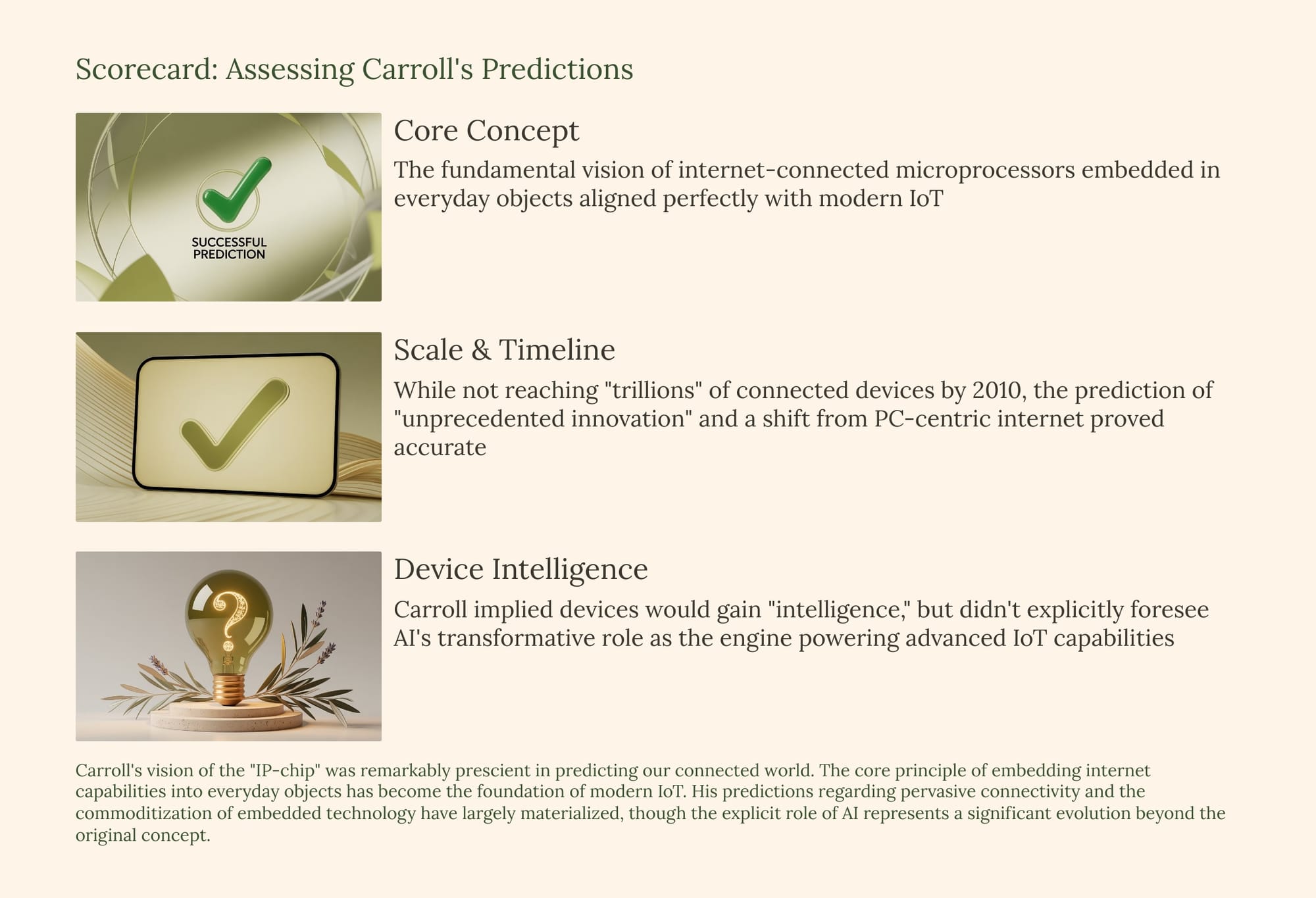
Not bad!
Futurist Jim Carroll has been speaking about this trend since at least 1994.

